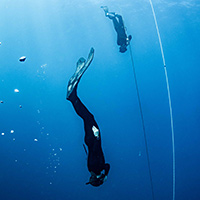Our team has now left Nosy Be in anticipation of the usual leaving date of the whale sharks but it seems this year whale sharks are spending the holidays in Nosy Be ! Needless to say, we are exhausted. But what a season it has been! Many many sharks, a great team and many achievements. Let us walk you through the 2018 season …

300 sharks and counting !
This year’s season was rather unusual. Sharks arrived spot on the 1st of October and stayed all month, then for two weeks we experienced bad weather due to a nearby cyclone and it seems whale sharks were just gone. When we finally saw Michel again, around the 10th of October, all of his remoras had gone (the small fish that encroach on the shark’s skin). We suspect he, like other whale sharks at that time, visited deeper waters and thus left his remora friends in the upper layer, as it seems remoras can only reach a depth of 85 meters. As you can expect we were thrilled to see the sharks back, and they did come back ‘en masse’. We even witnessed 14 sharks on the 26th November, a record !
Through this year’s season we collected data on 97 days, adding up to nearly 400 encounters with whale sharks ! All data is being processed and we will be able to come up with a final number for the season in a few months after having analysed all the encounters. I can already say we saw more than 120 individuals this year, a record number for the project , in addition to crossing the 300 line since the inception of the project in 2015!

Manta magic
We also had the privilege of experiencing a few ‘manta’ days in October and December where giant manta rays came to feed on large krill patches. Interestingly, the manta rays we observe in Madagascar are referred to as leucistic, a type of morph where manta rays in certain areas, although from the same species, bear whiter coloring. Such beauty … Like whale sharks, manta rays have unique spot patterns (on their bellies) that we photograph and upload online onto Manta Matcher to then recognise individuals and check whether they have been spotted elsewhere. This year we had more manta days than previous years, excited to see whether we see the same individuals year after year !

Expeditions and other developments
In October, together with project co-supervisor Dr. Simon Pierce and journalist Martin Fletcher we cruised to the stunning Mitsio Archipelago in search of whale sharks. We spotted lots of bait balls, Omura’s whales and humpback whales, but no whale sharks. It was very useful for us to finally discover this remote corner of our study area, but the catamaran was not ideal for research.
Sadly due to lack of funding I couldn’t go back to Analalava, the second hotspot off North-West Madagascar. We are however planning a one-of-a-kind exploratory expedition with Natural World Safaris for next season, using an appropriate research vessel to reach this remote area and study whale sharks. Limited places so contact us directly if you’d be interested !
We also welcomed Dr. Andrew Brierley and Dr. Martin Cox in December, who came to do an acoustic survey on small prey species that whale sharks seem to feed on. Excited to see the results !
We have started our socio-economic survey amongst both tourists and operators, and are pleased to have gathered quite a few, which will be crucial to further implement the code of conduct next year. Thanks to all the patient tourists for sitting through our interviews !

A big thank you
A big part of our data was collected by our amazing team of volunteers, thank you Juliette, Mario, Guillaume, Chloé, Pierre, Diane, Chantal, Fanny, Amandine, Raphaël, Tine, Léa, Floriant, Alexandra and Stéphane!
Léonce (pictured above) our field assistant, returned to university in Tuléar to write up his master thesis about whale shark spatial distribution in Nosy Be. He has been making great progress and we hope he can join us again next year. Bruno is off for the Christmas holidays, but will be continuing to deliver our education program over the next few weeks, finalising this first run of the program, and hopefully will stay with us in the future (see below !).
Thanks to our local operator Les Baleines Rand’eau for taking us out at sea, to our partners the Marine Megafauna Foundation and MADA Megafauna, travel companies Aqua-Firma and Natural World Safaris, to our funders VOCATIO, Clear Reef Social Fund, Idea Wild, Cressi and to project friend I Am Water Ocean Travel. Your support has been instrumental in making this season come to life. Special thanks go to Léa Gonçalves (Crowdfunding), Sophie Gaudin (Educational support), Melissa Hobson (PR) and Claire Eloy (Data entry) for their outstanding help, and to Marie-Noëlla Wai Lan Chan, Claudia Andrianaivo and Franklin Klaasse for adopting some of our whale sharks !
And to you too !

Last but not least, I wanted to thank everyone who participated to our ambitious crowdfunding campaign this last month, together we raised more than 8000 Euros! This means we can continue our education programme, scale it up and target more schools and kids by keeping Bruno year-round to widen our impact, an incredible achievement for our small team.
That’s all for now, stay posted for the results of this year’s season, coming soon !

 January 24, 2019
January 24, 2019